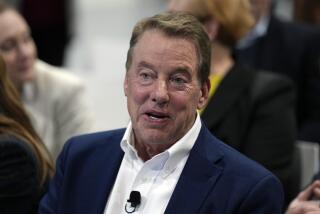The Driving Force Behind Ford’s Success : Profile: Under Donald E. Petersen, design, direction and timing have merged to make the firm the most profitable auto company in history.
- Share via
DEARBORN, Mich. — Donald E. Petersen says the worst day in his 40 years with Ford Motor Co. came shortly after he was named president in March, 1980, when he realized that the No. 2 auto maker was in worse shape than he’d thought.
“It was certainly a sobering day,” he said. “It was probably the most sobering day.”
The company had just reported a $1.17-billion loss for 1979, the second straight annual loss and a 30% decline over 1977’s performance. Ford’s financial slide was accelerating, hurt by rising gasoline prices and rising interest rates, which were making cars less affordable.
By the time Petersen’s first year as Ford’s president had ended, the company had reported a $1.54-billion loss. To the outside world, things looked pretty bad.
But sequestered from public view in Ford design studios were the cars that would help resurrect the company and make it one of the world’s most profitable corporations in less than a decade.
First the sleek Thunderbird and later the jelly-bean-like Taurus and Sable models became the weapons Ford used to slam-dunk its way back into the brutally competitive auto business, threatening No. 1 General Motors Corp.’s dominance.
“What was so striking to me about the Taurus was that it put the stamp of certified acceptance and rightness on the efforts of Ford Motor Co. in a fashion that I did not anticipate fully,” Petersen said. “To me, we had started the process long before.
“I thought of the ’83 Thunderbird as really, if you will, the benchmark car that really declared that there was going to be a very different direction, specifically in design of automobiles.”
Petersen was no stranger to watching cars develop from a sketch sheet to the assembly line.
Through the 1950s and ‘60s, he rose through the product planning division to become vice president for car planning and research in 1969. In the early 1970s, he was vice president and general manager of the company’s truck operations, giving him broad product experience.
Between then and the time he was elected to Ford’s board on Sept. 8, 1977, Petersen was executive vice president for diversified products, which linked the company with suppliers and subsidiaries, and was vice president for international operations.
Some analysts have said his role overseeing foreign operations gave him a view of the international automobile industry that has spurred Ford to break out of the Big Three car-making mold.
The introductions of the Taurus and Sable--on the day after Christmas, 1985--proved to be the gift that has kept on giving for Ford.
By then, the company was well into a painful cost-reduction program that scrapped the paring knife and instead used a cleaver to eliminate what Petersen and his colleagues considered excessive and redundant. At the same time, gasoline prices and interest rates were falling.
“I think it was all of this coming together in that type of car that created almost a sensation that I didn’t expect,” Petersen said.
Earlier that year, Petersen became board chairman and chief executive. In 1985, Ford made $2.52 billion.
Ford has been on a roll since the Taurus-Sable introduction, stealing sales and market share from GM, fighting off foreign competition more easily than other domestic manufacturers and keeping a lid on manufacturing expansion through the use of overtime instead of expensive new factories.
One of the big problems for auto makers in the 1990s promises to be overcapacity--too many assembly lines producing too many cars for a saturated market. It likely will affect Ford less than others.
“If the scenario is roughly what we think it will be--slow growth, an industry down some, perhaps, from this year--Ford should be in a pretty good position to deal with most of the problems by fluctuating overtime,” Petersen said.
It is that outlook of soft growth that has pushed Ford into other directions under Petersen’s guidance.
For example, the auto maker has expressed interest in buying all or part of such well-known European auto makers as Britain’s Jaguar to strengthen its worldwide operations.
Ford also has made major moves into financial services to cushion the blow of any auto industry downturn. Last July, for instance, it announced the $3.35-billion purchase of the Associates, a major provider of consumer financing, from Paramount Communications Corp.
Petersen is making no predictions about the level of car and truck sales in 1990. “We want to see a little bit more of the fourth quarter (of 1989) before we start quantifying next year,” he said.
“We do think that it’s likely to be off some from the 1989 calendar year, but not a dramatic drop.” In fact, he added, Ford’s sales should continue to grow, which would give it a larger share of a smaller market.
Petersen said much of the reason for Ford’s comeback stems from a management meeting in 1984 when the company’s leadership adopted “Company Mission, Values and Guiding Principles”--a statement of Ford’s goals.
“I’ll always remember Henry Ford II devoting his entire talk to the then-new statement of MVGP at Ford,” Petersen said. “As he left the podium, he said to me ‘Pete, I hope I gave your new statement of what we want to be a good send-off.’
“That really was a certification that we really are going to change. At that point, we were very much in the process of change.”
Under Petersen’s direction, the company became the most profitable auto maker in history. In 1986, Ford made $3.29 billion, raised that to $4.63 billion in 1987 and set an industry record $5.3 billion in profit in 1988.
Honors have been heaped on Petersen for work in and out of the automobile industry. Yet his office has none of the numerous plaques he has received over the years. In fact, there is little indication, save a life-size bust of the Greek god Mercury by Marshall Fredericks, that it’s the seat of management for Ford Motor Co.
In the place of plaques, certificates and official proclamations are things near and dear to Petersen and his wife, Jody.
And then there are the rocks.
Not just any rocks, but minerals collected from all over the world.
A case contains raw and finished forms of dozens of minerals--an emerald from Muzo, Colombia; cinnabar from China’s Hunan Province; and imperial topaz from Minas Gerais, Brazil.
In a private meeting room as a centerpiece on a small table, there is an unusually large specimen of twinned quartz.
“My interest is what’s beautiful and what’s pretty,” Petersen said. “And then you go on to see if it’s perfect.”






